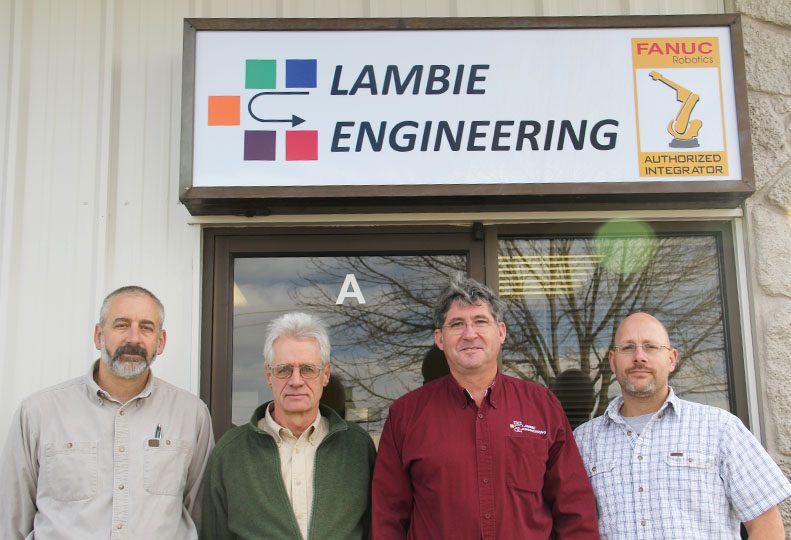
Home » Engineering firm slims down machine manufacturing
Engineering firm slims down machine manufacturing
Lambie uses 'right-sized' technology, robotics to streamline processes

November 7, 2013
Lambie Engineering LLC, of Spokane Valley, is hoping to revolutionize the way companies fabricate parts through the concept of lean manufacturing.
One of the tenets of lean manufacturing, says Lambie Engineering President and owner Ken Lambie, involves using specially-engineered equipment to make only as many parts as are needed to meet short-term customer demand, thereby reducing waste and making product flow more effective.
"We make machines that make product at what the demand is," Lambie says. "In the lean community it's called 'right-sized' equipment."
Lambie Engineering, he says, makes machines that are smaller, produce fewer parts, or run at a slower pace so that companies can make only as many parts as they need, when they need them.
There are a few reasons, Lambie says, why a company might be manufacturing more parts than its demand necessitates. Some manufacturing machines are large and can only make parts in large batches. Lambie says companies also will make large batches of parts at one time to make up for the time and effort it takes to manufacture the part. There are also machines that produce parts at a faster rate than is necessary to meet demand. In these situations, the company ends up with a large surplus of parts that it isn't using, Lambie says.
As an example, in 2011, the company handled a project for the appliance division of General Electric Co., where it made the machines for manufacturing the front panel of two different dishwashers. Lambie Engineering made both a notch machine, which cuts metal like a cookie cutter, and a form machine, which bends the metal panels into the desired shape. The machines, which Lambie describes as right sized, were used to streamline the manufacturing process, he says.
Lambie says the company also made a right-sized automated painting booth for Spokane manufacturer Triumph Composite Systems Inc., a subsidiary of Pennsylvania-based Triumph Group Inc., to paint two different light fixtures for Boeing 747 cargo planes. The booth enabled the painting process to take place in the production line, instead of in large batches in a different location, thereby improving product flow.
Lambie Engineering also has worked on projects for a number of other recognizable companies, including Whirlpool Corp., Kenworth Truck Co., Boeing Co., and Spokane's Berg Cos. and Lloyd Industries Inc.
Lambie founded the company in 2010, he says. Prior to that, he was an engineer at Kimball Office, a unit of Kimball International Inc., in Post Falls.
Lambie Engineering moved in September from its 700-square-foot space at 15404 E. Springfield to 1250-square-foot space at 3020 N. Sullivan, Lambie says. The firm decided to move to have more shop space, Lambie says. For the year 2013, the company expects to have $275,000 in revenue. That would be up from its 2012 revenue, Lambie says, but down slightly from 2011, when the company completed the project for GE.
Currently, Lambie and Tom Courrier are the only full-time employees at Lambie Engineering.
The company also employs two part-time workers, Josh Swenson and Tim Adams, who also pursue their own projects outside of Lambie Engineering.
Lambie is a mechanical engineer, Courrier is an electrical controls engineer, Swenson is a journeyman tool and die maker and computer numerical control machinist, and Adams is a millwright, welder, and fabrication specialist.
"Between the four of us, we have the capability to build sophisticated machines," Lambie says. "We all understand production flow and how important that is."
Lambie also says that the friendship between the four men contributes to the company's success.
"Friendship, trust, and respect create a cohesive team," he says.
The firm also uses robotics in some of its projects, and is certified by Fanuc American Corp. as a robotics integrator.
The company buys the device, usually a robotic arm, Lambie says, from Fanuc and then Lambie Engineering designs and makes the periphery equipment necessary to run the robotic device in a production cell.
Robotics, Lambie says, can be used to perform jobs that are repetitive, dirty, or dangerous for humans to do.
"In a lot of cases, there are really tedious jobs, very repetitive," Lambie says. "A robot can be used to automate those very repetitive tasks. That can be less expensive than the labor, depending on the situation. If the volumes are sufficient enough, we can replace labor with machine. It can also be dirty or dangerous, so from a safety standpoint, we may want to use automation."
Lambie says the company doesn't use robotics in its machines to replace human labor altogether, but rather to streamline the manufacturing process.
"We don't want to automate to get rid of people," he says. "We want to automate to grow, so we can use our human labor where it's needed more."
For the future, the company is focused on building its customer base, Lambie says. "Things are evolving," he says. "We're supporting more manufacturing companies." However, Lambie says, right-sized equipment can sometimes be a tough sell to companies that aren't familiar with the practice.
"We're looking to take our niche and move into other markets," he says.
He says the business also is looking to obtain an AS (90) 100 certification so it can pursue projects with Boeing. The AS (90) 100 is a quality systems certification, Lambie says.
To become certified, the company needs to have a documented quality system in place that meets the standards of the certification. Lambie says a consultant will be visiting the company on Nov. 15 to get the process started.
Latest News Up Close Manufacturing
Related Articles
Related Products



![Brad head shot[1] web](https://www.spokanejournal.com/ext/resources/2025/03/10/thumb/Brad-Head-Shot[1]_web.jpg?1741642753)
